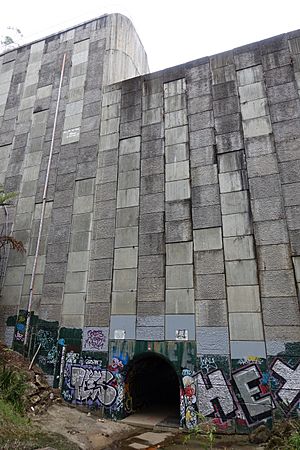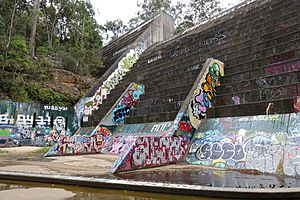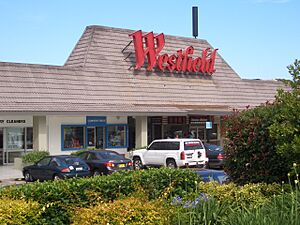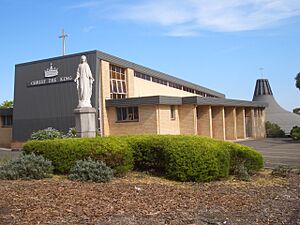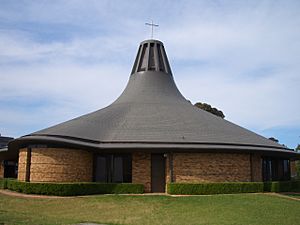North Rocks, New South Wales facts for kids
Quick facts for kids North RocksGreater Western Sydney, New South Wales |
|||||||||||||||
|---|---|---|---|---|---|---|---|---|---|---|---|---|---|---|---|
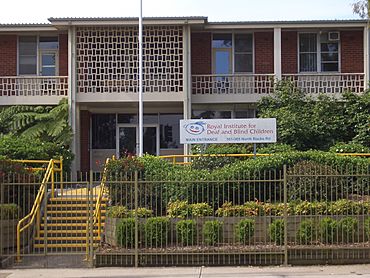
Royal Institute for Deaf and Blind Children c. 2007
|
|||||||||||||||
| Population | 7,965 (2016 census) | ||||||||||||||
| Postcode(s) | 2151 | ||||||||||||||
| Elevation | 112 m (367 ft) | ||||||||||||||
| Location | 26 km (16 mi) north-west of Sydney CBD | ||||||||||||||
| LGA(s) |
|
||||||||||||||
| State electorate(s) | Epping | ||||||||||||||
| Federal Division(s) | |||||||||||||||
|
|||||||||||||||
North Rocks is a suburb in Greater Western Sydney, New South Wales, Australia. It's about 26 kilometers north-west of the Sydney city center. North Rocks is part of both the Hills District and the North Shore areas of Parramatta.
Since 2016, most of North Rocks is managed by the City of Parramatta council. However, streets north of the M2 Hills Motorway are part of The Hills Shire council area.
Contents
Discovering North Rocks' Past
How North Rocks Got Its Name
The name North Rocks is very old, even older than the city of Parramatta itself! In 1789, Governor Phillip set aside large areas north and west of Rosehill (which is what Parramatta was first called). These areas were for government farm animals. The northern part of this land was known as 'the North Rocks'. People also sometimes called this area Jerusalem Rocks.
First People of North Rocks
The land of North Rocks, including Hunts and Darling Mills Creeks, was originally home to the Burramattagal clan. They were part of the Darug nation. Their name, Burramattagal, means "place of fresh running water where eels and fish are found."
The Famous Sandstone Rocks
The "North Rocks" were once huge sandstone cliffs. They were so big and important that they gave the area its name. Sadly, these rocks are no longer there. In 1841, when a new prison was being built in Parramatta, a builder bought the rocks. They were made of the best sandstone around and were easy to get to. Much of the North Rocks became the walls and floors of the new prison in 1844. More stone was used in 1855-56 to build the wall that holds back the water of Lake Parramatta. This wall is about 73 meters long and 4.5 meters thick at the bottom!
Post Office History
The first Post Office in North Rocks opened on 1 February 1894. It changed its name a few times before closing in 1970. The Post Office that is there today opened on 1 November 1921.
From Farms to Homes
Before 1958, North Rocks was mostly farmland. There were about 40 farms, growing peaches and nectarines, and raising chickens and pigs. When the area was changed for housing, many new neighborhoods were built, like Lynwood Estate.
Shopping and Businesses in North Rocks
North Rocks Shopping Centre
The main shopping area in North Rocks is around North Rocks Road. The shopping center was built in the 1970s. It has a Coles Supermarket, a Kmart store, and over 70 smaller shops. It used to be a Westfield Group center until 2015. Next to the shopping center, you can find an Aldi supermarket, Anytime Fitness gym, and First Choice Liquor. There are also a few shops across the road.
North Rocks Markets
Every Sunday, the local Rotary Club runs the North Rocks Markets. It's a "trash and treasure" market where you can find new and used items, food, and even computer parts. You can get in by giving a small donation. The market has been running for over 20 years at different places in the area, including the Royal Institute for Deaf and Blind Children.
Local Businesses
Towards North Parramatta, there's an area with many industrial businesses. Big companies like Unilever and Officeworks have offices and factories there.
Getting Around North Rocks
Driving and Public Transport
In 2016, most people in North Rocks (about 69%) drove to work. About 17% used public transport. The M2 Hills Motorway goes through North Rocks, making it easy to drive to other parts of Sydney.
Bus Services
Buses are the main way to get around North Rocks using public transport. The Barclay Road M2 Bus Station offers services to the city center, Castle Hill, Macquarie Park, Blacktown, and Norwest Business Park. A bus trip from Barclay Road to the city takes about 22 minutes. Sydney Buses also connect Parramatta railway station to Epping railway station through different parts of North Rocks.
Train Stations Nearby
North Rocks does not have its own train station. However, you can catch a train from nearby stations like Epping, Castle Hill, and Parramatta.
Schools in North Rocks
North Rocks has several schools for different age groups.
Public Schools
- North Rocks Public School (which has a special class for gifted students)
- Burnside Public School
- Muirfield High School: This is a smaller high school with about 850 students. It's known for its farming program, which runs from the Barclay farm. The school has shown its farm animals and produce at the Castle Hill Show since 1992. In 2010, Muirfield High School even won second place at the Sydney Royal Easter Show for its fruit and vegetable display!
Private Schools
- Christ the King Catholic Primary School
Higher Education
- United Theological College
Places of Worship
North Rocks has several churches for different faiths:
- Liberty Baptist Church
- North Rocks Anglican Church
- Christ the King [Catholic Church]
- North Rocks Community Church [Uniting Church]
- Sydney Saesoon Presbyterian Church
Fun and Recreation in North Rocks
North Rocks has many places for sports and outdoor activities. There are large reserves like Hunts Creek Reserve, which has a beautiful waterfall called Balaka Falls. You can also find sports fields, a community center, and active community groups like Rotary, Lions, Scouts, and Girl Guides.
Golf fans can enjoy the Muirfield Golf Club, which has an 18-hole golf course on Barclay Road. There are also local clubs for softball, soccer, and rugby. If you love walking, you can explore the Murri-Yanna Track in Bidjigal Reserve. North Rocks even hosted the Skateboard Winter Olympics back in 1976!
Nature and Wildlife in North Rocks
Parks and Reserves
North Rocks is home to several parks and reserves. One of the most important is the Bidjigal Reserve. This reserve has tall eucalyptus trees, old sandstone cliffs, clear creeks, and shady rainforest areas. It surrounds the northern and western edges of North Rocks.
Amazing Animals
You can find many different animals in Bidjigal Reserve, including koalas, swamp wallabies, echidnas, sugar gliders, and eastern water dragons. Platypus used to be seen regularly in the creeks until the 1970s. The reserve is also famous for its birds, with 127 different types recorded! You might spot small birds like wrens and thornbills, or more common ones like kookaburras and crimson rosellas. In recent years, there have been more sulphur-crested cockatoos and rainbow lorikeets. The powerful owl, Australia's largest owl, also lives and breeds in the reserve. You can often hear its hooting sound throughout North Rocks at night. Many of these birds can be seen all over North Rocks.
Who Lives in North Rocks?
In 2016, there were 7,965 people living in North Rocks. The average age of residents was 41 years old.
Age Groups
- Children aged 0–14 years made up about 20.5% of the population.
- People aged 65 years and older made up about 18.2% of the population.
Where People Come From
- About 62% of people in North Rocks were born in Australia.
- Other common countries of birth include China (8.7%), South Korea (3.1%), England (2.8%), India (2.0%), and Hong Kong (1.9%).
- The most common family backgrounds are English, Australian, Chinese, Irish, and Scottish.
Languages Spoken
- About 62% of people speak only English at home.
- Other languages spoken at home include Mandarin (9.7%), Cantonese (6.5%), Korean (4.0%), and Arabic (1.9%).
Beliefs
- In 2021, about 59.7% of the population were Christians.
- The largest non-Christian religion was Hinduism, making up 4.3% of the population.
- About 33% of people said they had no religion.
Homes in North Rocks
- Most homes (about 90%) are separate houses.
- About 7.7% are townhouses or similar, and 1.7% are apartments.
- Most homes are either fully owned (41.9%) or being paid off with a mortgage (42.4%). Only about 14% are rented.
- The average household has 3 people.


